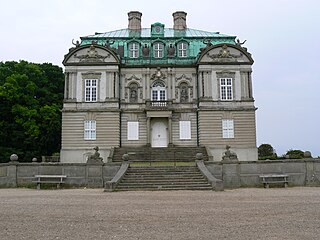
Mantua is a city and comune in Lombardy, Italy, and capital of the province of the same name.

The Palazzina di caccia of Stupinigi is one of the Residences of the Royal House of Savoy in northern Italy, part of the UNESCO World Heritage Sites list. Built as a royal hunting lodge in the early 18th century, it is located in Stupinigi, a suburb of the town of Nichelino, 10 km (6 mi) southwest of Turin.

The Palazzo Ducale di Mantova is a group of buildings in Mantua, Lombardy, northern Italy, built between the 14th and the 17th century mainly by the noble family of Gonzaga as their royal residence in the capital of their Duchy. The buildings are connected by corridors and galleries and are enriched by inner courts and wide gardens. The complex includes some 500 rooms and occupies an area of c. 34,000 m2, which make it the sixth largest palace in Europe after the palaces of the Vatican, the Louvre Palace, the Palace of Versailles, the Royal Palace of Caserta and the Castle of Fontainebleau. It has more than 500 rooms and contains seven gardens and eight courtyards. Although most famous for Mantegna's frescos in the Camera degli Sposi, they have many other very significant architectural and painted elements.

The Residences of the Royal House of Savoy are a group of buildings in Turin and the Metropolitan City of Turin, in Piedmont. It was added to the UNESCO World Heritage Sites list in 1997.

Marmirolo is a comune (municipality) in the Province of Mantua in the Italian region Lombardy, located about 130 kilometres (81 mi) east of Milan and about 7 kilometres (4 mi) northwest of Mantua. Its territory, which is totally plain as part of the Pianura Padana, is crossed by the Mincio river.
Stupinigi, with some 200 inhabitants, is today a hamlet of the comune of Nichelino, in the Metropolitan City of Turin. It borders with the comuni (municipalities) of Candiolo and Orbassano on the southwestern outskirts of Turin, about 10 km from the centre of the city. Before 1869, it formed part of the comune of Vinovo.

The Hermitage Hunting Lodge is located in Dyrehaven north of Copenhagen, Denmark. The hunting lodge was built by architect Lauritz de Thurah in Baroque style from 1734 to 1736 for Christian VI of Denmark in order to host royal banquets during royal hunts in Dyrehaven.

The Palace of Venaria is a former royal residence and gardens located in Venaria Reale, near Turin in the Piedmont region in northern Italy. It is one of the Residences of the Royal House of Savoy, included in the UNESCO Heritage List in 1997.

The Royal Palace of Capodimonte is a large palazzo in Naples, Italy. It was formerly the summer residence and hunting lodge of the Bourbon kings of the Two Sicilies, one of the two royal palaces in Naples. Today, it comprises the National Museum of Capodimonte and the Royal Forest. The palace was constructed on its somewhat cooler hilltop location just outside the city, with urban Naples ultimately expanding around it.

The Palazzo Santa Margherita is a Neoclassical-style palace located on Corso Canalgrande #103 in the central Modena region of Emilia-Romagna in Italy.

The Galleria degli Antichi and the Palazzo del Giardino are adjacent, contemporaneous, Renaissance-style buildings located on Piazza d`Armi #1 in Sabbioneta, in the Province of Mantua, region of Lombardy, Italy. Prior to 1797, the buildings were connected to the Rocca or Castle of Sabbioneta, and the gallery once housed the Gonzaga collection of antique Roman statuary and hunting trophies. While the architectural design of the gallery is striking, the richness of the interior decoration of the palazzo is also dazzling.

Ficuzza is a southern Italian village and hamlet (frazione) of Corleone, a municipality in the Metropolitan City of Palermo, Sicily. in 2011 it had a population of 112.

The Palazzo San Sebastiano is a 16th-century palace in Mantua. Built by the Gonzaga family, since 19 March 2005 it has housed Mantua's city museum.

Palazzo Gonzaga-Acerbi is a historic palace in Castel Goffredo in the Province of Mantua in Italy.

The Castello di San Giorgio is part of the Ducal palace of Mantua. It is a moated rectangular castle, each of which's four corners has a large tower and the moat is crossed by three drawbridges.

Villa Giraffa is a rural palace located on the banks of the Mincio River, near the town of Goito, province of Mantua, Lombardy, Italy. It was initially remodeled in the 15th century as a villa by the ruling Gonzaga family.

The Basilika Palatina di Santa Barbara is the Palatine Chapel of the House of Gonzaga in Mantua, Italy.

Palazzo Cavriani is an aristocratic palace with gardens located in Mantua, Italy. The palace is also sometimes referred to as the Palazzo Gonzaga-Spolverini, but the palace belonging to those families was either razed or subsumed into the present neoclassical structure and garden.

Palazzina Appiani is a historical building located in Milan, northern Italy. It was built as the entrance hall of the arena at the beginning of the 19th century by the French, who occupied Milan in 1796. Its original function was to be the official gallery and guest residence to host Napoleon's family during his public appearances. It is located in Parco Sempione, the biggest park in the city, which also comprises the Sforza Castle and the Arch of Peace. Adjacent to the Arena Civica, the Palazzina is now entrusted to FAI – Fondo Ambiente Italiano.

The Palazzina Reale delle Cascine is a small Neoclassical palace sited on the Piazzale delle Cascine within the public park located along the north bank of the Arno river just north of central Florence, Italy. Built in the mid-18th century by the Lorraine Duke of Florence, in 2020 now houses part of the offices of the faculty of agricultural and forestry sciences of the University of Florence.



















